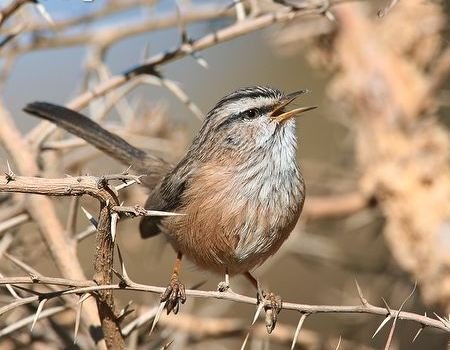Scotocercidae – Streaked Scrub Warbler

The streaked scrub warbler (Scotocerca inquieta) is a passerine in the Scotocercidae family from Africa and south-western Asia. It is a bird of desert fringes and open desert with a sparse cover of scrub, especially wadi beds with a denser cover than the surrounding desert, as well as scree areas with bushes in ravines and gorges. It is mainly resident, although local movements can occur outside the breeding season. The family Scotocercidae has just this one member.
It is a small, skulking desert warbler which cocks its tail over its back. The adults are grey brown above, finely streaked with dark brown. They have a broad pale supercilium and a thin black eyestripe. The underparts are whitish with reddish flanks and vent, the breast is finely streaked. The tail is graduated and dark brown with a white tip. Juveniles are duller.
Its song is distinctive and is rendered as ‘zit-zit dweedle-doolredle-doleed’
The streaked scrub warbler nests in low scrub up to 1.5m above the ground, the nest is a domed structure made of grass and twigs and lined with feathers, fur and plant down. It has 1-2 side entrances, if there is a second it is used only as an exit. The clutch size averages 3-5 but varies from 2-5, incubation is roughly two week with another two weeks before the young fledge. Its main food is insects but it will also eat seeds which may be very important in winter. It forages on the ground, fossicking through leaf litter and other debris under bushes, and into cavities but will also feed up in the vegetation at times. No particular threats have been identified and the population is believed to be steady or declining slightly.
Streaked Scrub Warbler Scotocerca inquieta
-
Streaked Scrub Warbler Scotocerca inquieta
Species AccountSound archive and distribution map -
Streaked Scrub Warbler Scotocerca inquieta
Species AccountThe streaked scrub warbler (Scotocerca inquieta) is a species of bird in the Scotocercidae family from Africa and south-western Asia. It is a bird of desert fringes, frequenting scrubby areas, ravines and gorges, and is mainly resident, although local movements can occur outside the breeding season
-
Number of bird species: 1
